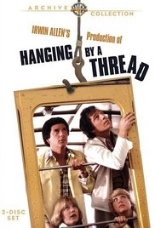
 You’re a talented metallurgical engineer. (Just go with me here.) You’re blowing the whistle on your bosses for defrauding the federal government and putting troops’ lives at risk. You’re told you’re a dead man for doing so. You’re set to testify against them in mere days. You’re under witness protection. You’ve already survived one attempt on your life via the ol’ “phony mail carrier with a gun” routine. And yet you purposely leave the safe house to attend a previously scheduled picnic with friends and family, in public.
You’re a talented metallurgical engineer. (Just go with me here.) You’re blowing the whistle on your bosses for defrauding the federal government and putting troops’ lives at risk. You’re told you’re a dead man for doing so. You’re set to testify against them in mere days. You’re under witness protection. You’ve already survived one attempt on your life via the ol’ “phony mail carrier with a gun” routine. And yet you purposely leave the safe house to attend a previously scheduled picnic with friends and family, in public.
You, sir, are a goddamn idiot who deserves to eat lead.
However, producer Irwin Allen, never met a patently absurd setup he could not milk for a telefilm buck. And after fires, floods and rock slides, the Master of Disaster was down to arguably his most incredulous concept yet: being stuck in a cable car. Ladies and gentlemen, you are Hanging by a Thread.
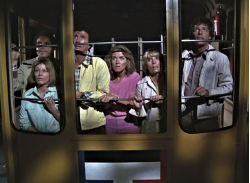 The trouble begins when engineer Paul Craig (Sam Groom, Deadly Eyes) decides to ditch the protective care of the feds — by himself, by his own choice and for the night so he may accompany his son, Tommy (Michael Sharrett, Wes Craven’s Deadly Friend), on a private picnic atop a mountain accessible only via aerial tram. Not happy to see Paul show up is his ex-wife, Ellen (Donna Mills, Allen’s Fire); in turn, Paul is not happy to see her being pawed by his old friend, Alan (Bert Convy, The Cannonball Run), to whom Ellen is now engaged. The members of this love triangle — and the other eager picnickers (one played by Valley of the Dolls’ Patty Duke) — were such perennial partiers, they formed their own WASPs’ nest, called the Uptowners’ Club.
The trouble begins when engineer Paul Craig (Sam Groom, Deadly Eyes) decides to ditch the protective care of the feds — by himself, by his own choice and for the night so he may accompany his son, Tommy (Michael Sharrett, Wes Craven’s Deadly Friend), on a private picnic atop a mountain accessible only via aerial tram. Not happy to see Paul show up is his ex-wife, Ellen (Donna Mills, Allen’s Fire); in turn, Paul is not happy to see her being pawed by his old friend, Alan (Bert Convy, The Cannonball Run), to whom Ellen is now engaged. The members of this love triangle — and the other eager picnickers (one played by Valley of the Dolls’ Patty Duke) — were such perennial partiers, they formed their own WASPs’ nest, called the Uptowners’ Club.
Being a fatuous, wealthy douche who lives to show off and bend others to his bank-enabled will, Alan gives the go-ahead to board the tram, despite a doozy of an approaching thunderstorm. Wouldn’t you know it, lightning strikes the cables and fries some metal doohickey, effectively stranding the group approximately 7,500 in the air. With high winds preventing copter rescue, the plot pits Paul against Alan in a race to nut up and Be a Hero, Just for One Day. Although we’re barely an hour into this three-hour-plus armchair gripper, Paul handily wins, because Alan’s alcoholism gets the *hic!* better of him; rather than take swift action, Alan takes increasingly larger swigs from a heretofore hidden flask as big as his head.
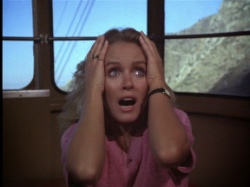 So how do vowel-deprived director Georg Fenady (Cave In!) and scripter Adrian Spies (The Ordeal of Patty Hearst) fill the time before Paul inevitably saves the day? If you guessed “play Win, Lose or Draw,” I like where your head’s at, but you’re eight years off. The answer: flashbacks, natch! Each adult gets his or her turn to mentally turn back the clock and revisit closeted skeletons such as framing a family member for corporate malfeasance, coveting thy neighbor’s wife and that time they got so shit-faced, they murdered Doug Llewelyn of TV’s People’s Court. Now that was a party!
So how do vowel-deprived director Georg Fenady (Cave In!) and scripter Adrian Spies (The Ordeal of Patty Hearst) fill the time before Paul inevitably saves the day? If you guessed “play Win, Lose or Draw,” I like where your head’s at, but you’re eight years off. The answer: flashbacks, natch! Each adult gets his or her turn to mentally turn back the clock and revisit closeted skeletons such as framing a family member for corporate malfeasance, coveting thy neighbor’s wife and that time they got so shit-faced, they murdered Doug Llewelyn of TV’s People’s Court. Now that was a party!
And so is Hanging by a Thread, even with so many signs suggesting otherwise: specifically, the daunting running time, the cockamamie concept and all that Convy. Yet as the soap bubbles and bubbles to a fine moisturizing lather, the made-for-TV movie gets by on its sheer unhipness and the surprisingly strong work from Groom. When at the end, the brakeless car careens downward toward the starting point and an uncertain fate for all involved (bringing new meaning to the phrase “exit through the gift shop”), I’ll admit I felt my toes tense just a tad — like Speed with flared collars, dumber characters and a better view. —Rod Lott
Get it at Amazon.
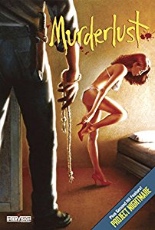
 Security guard Steve Belmont (Eli Rich, The Jigsaw Murders) possesses MurderLust in his heart. The Sunday school teacher has a hobby of hiring hookers, but he only gets his rocks off by strangling them. Then he dumps their dead bodies off a desert cliff, eventually earning him the TV-news nickname of “the Mojave Murderer” — once the cops discover the spot, nine corpses (and untold vultures and flies) later. Steve seems not too terribly anxious about this development; he has bigger worries in ditching his check-seeking landlord.
Security guard Steve Belmont (Eli Rich, The Jigsaw Murders) possesses MurderLust in his heart. The Sunday school teacher has a hobby of hiring hookers, but he only gets his rocks off by strangling them. Then he dumps their dead bodies off a desert cliff, eventually earning him the TV-news nickname of “the Mojave Murderer” — once the cops discover the spot, nine corpses (and untold vultures and flies) later. Steve seems not too terribly anxious about this development; he has bigger worries in ditching his check-seeking landlord.  While they know not of Steve-o’s predilection for prostitutes, we sure do, and the joy of the film is in seeing him somehow pull off this charade while acting like a grade-A asshole to damn near everybody. Rich gives a real performance here, if not a terribly nuanced one — certainly stronger than the average VHS shocker ever asked for or deserved. Primarily (but not exclusively) for that reason, MurderLust is an above-average example of its kind: a lumbering, semi-lovable goof of a movie that keeps most of its carnage out of sight and its purpose to entertain on the cheap thoroughly in check. —Rod Lott
While they know not of Steve-o’s predilection for prostitutes, we sure do, and the joy of the film is in seeing him somehow pull off this charade while acting like a grade-A asshole to damn near everybody. Rich gives a real performance here, if not a terribly nuanced one — certainly stronger than the average VHS shocker ever asked for or deserved. Primarily (but not exclusively) for that reason, MurderLust is an above-average example of its kind: a lumbering, semi-lovable goof of a movie that keeps most of its carnage out of sight and its purpose to entertain on the cheap thoroughly in check. —Rod Lott
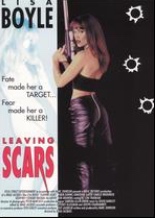

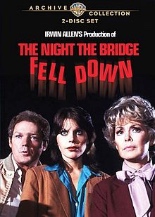
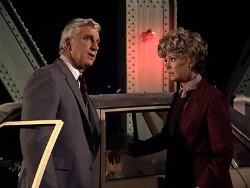
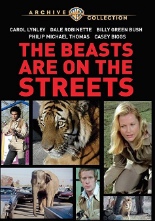
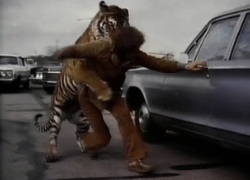 For this disaster-minded take on the Ivan Tors family comedy
For this disaster-minded take on the Ivan Tors family comedy 

